Lifeline Systems FD100SL Personal Help Button/Auto-Alert Help Button User Manual
Lifeline Systems Inc Personal Help Button/Auto-Alert Help Button
User Manual
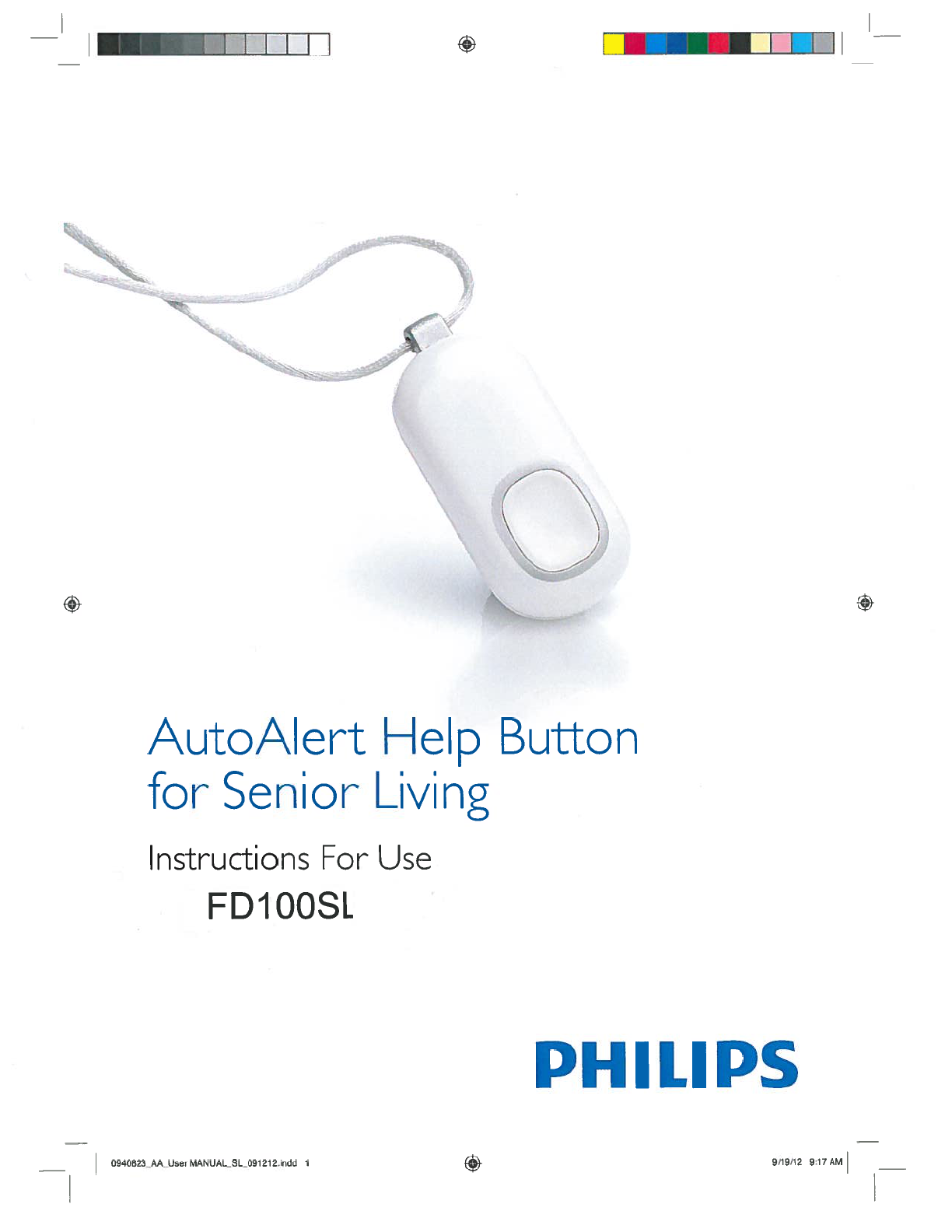
AutoAlert
Help
Button
for
Senior
Livi
Instructions
For
Use
FDI
OOSL
PHILIPS
ng
0940823_AA_User
MANUAL_SL091
21
2.indd
1
+
9/19/12
9:17
AM
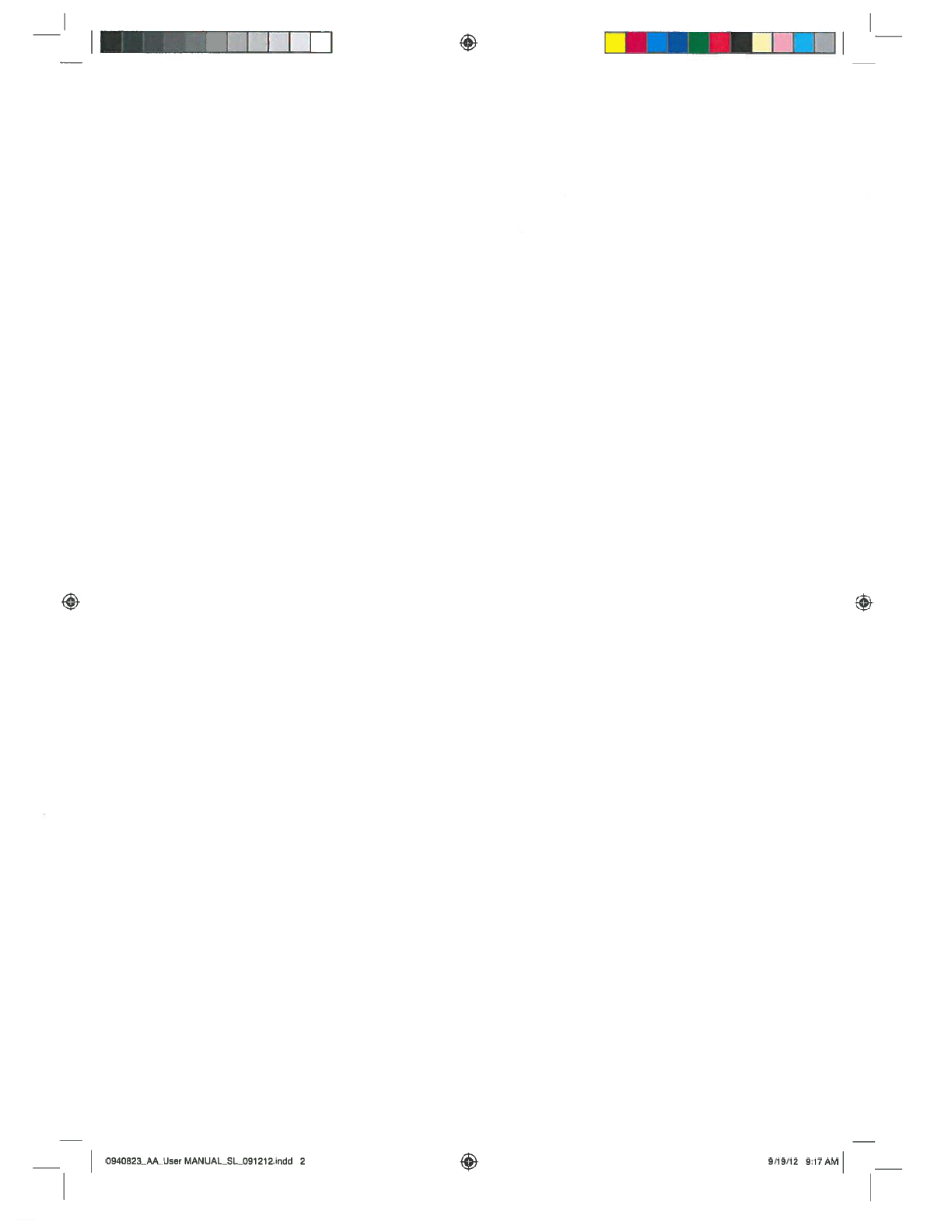
JmSRI
0940823AA_User
MANUAL_SLO91
21
2.indd 9/19/12
9:17
AM
+
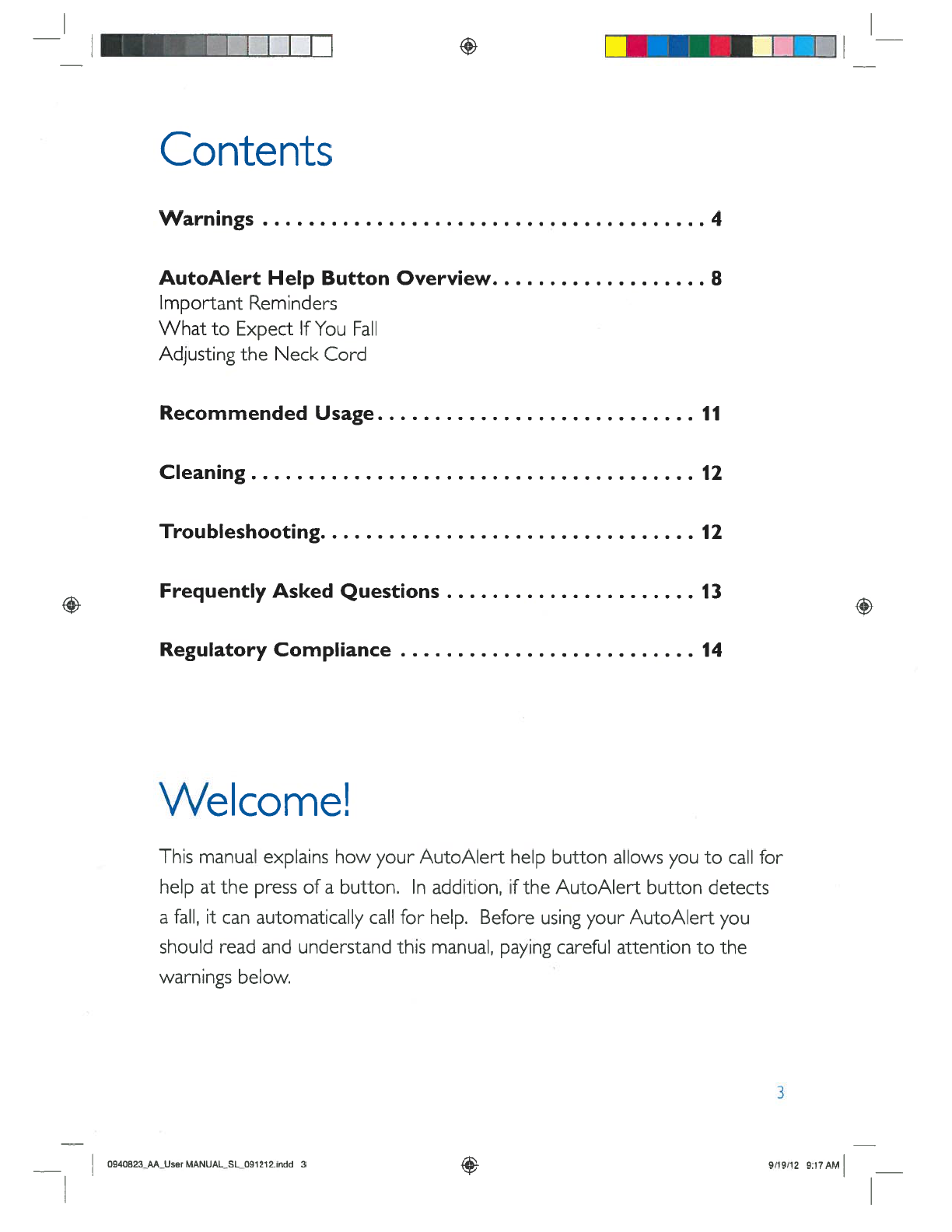
Contents
VVarnings
4
AutoAlert
Help
Button
Overview
8
Important
Reminders
What
to
Expect
If
You
Fall
Adjusting
the
Neck
Cord
Recommended
Usage
11
Cleaning
12
Troubleshooting
12
Frequently
Asked
Questions
13
Regulatory
Compliance
14
Welcome!
This
manual explains
how
your
AutoAlert
help
button
allows
you
to
call
for
help
at
the
press
of
a
button.
In
addition,
if
the
AutoAlert button
detects
a
fall,
it
can
automatically
call
for
help.
Before
using
your
AutoAlert
you
should
read
and
understand
this
manual,
paying
careful
attention
to the
warnings
below.
3
0940823_PA_User MANUALSLO91212.indd
3
9/19/12
9:17
AM
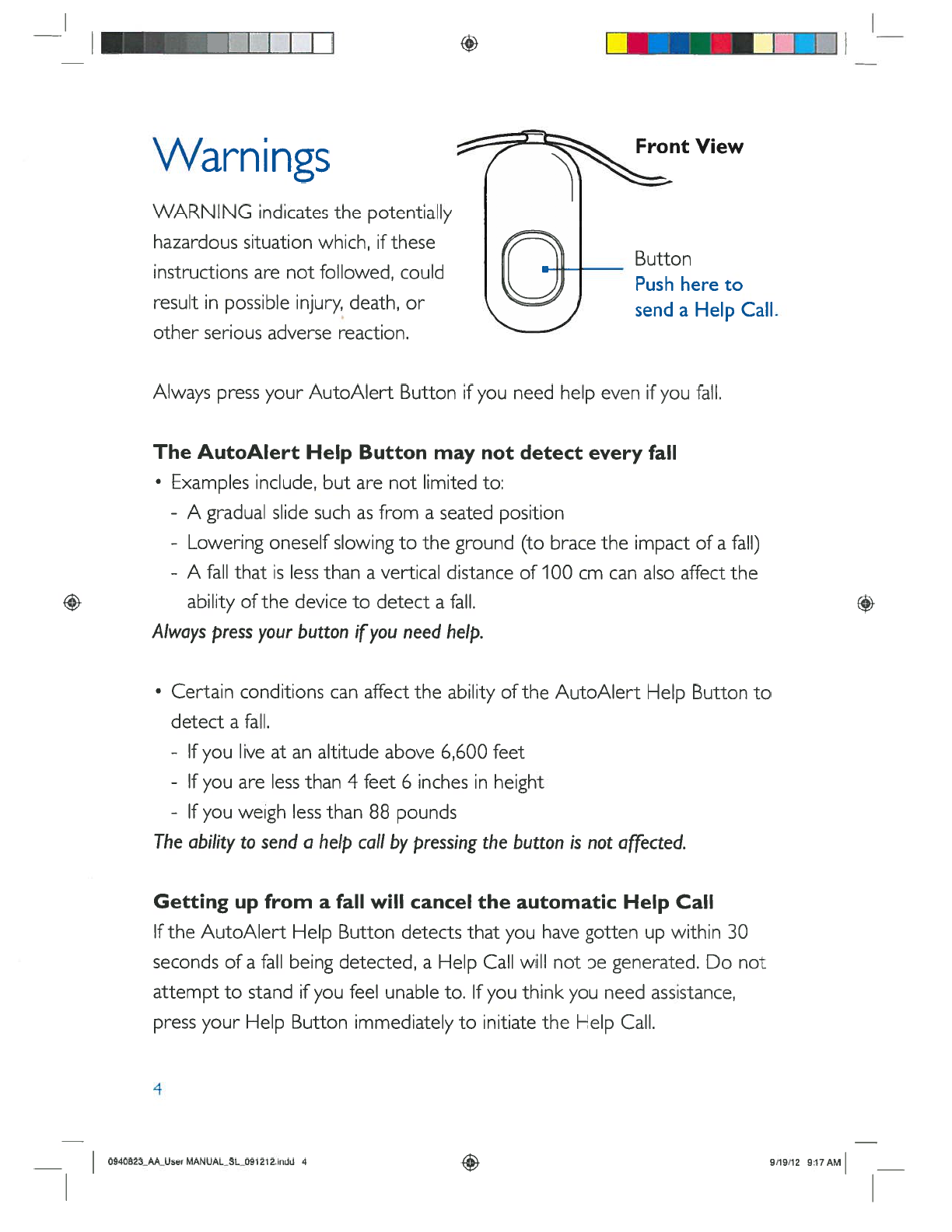
I I
I
I
VVarn ings
Front
View
WARNING
indicates
the
potentially
hazardous
situation
which,
if
these
Button
instructions
are
not
followed,
could Push
here
to
result
in
possible
injury,
death,
or
send
a
Help
Call.
other
serious
adverse
reaction.
Always
press
your
AutoAlert
Button
if
you
need
help
even
if
you
fall.
The
AutoAlert
Help
Button
may
not
detect
every
fall
•
Examples
include,
but
are
not
limited
to:
-
A
gradual
slide
such
as
from
a
seated
position
-
Lowering
oneself
slowing
to
the
ground
(to
brace
the
impact
of
a
fall)
-
A
fall
that
is
less
than
a
vertical
distance
of
100
cm can also
affect
the
ability
of
the
device
to
detect
a
fall.
Always
press
your
button
if
you
need
help.
•
Certain
conditions
can
affect
the
ability
of
the
AutoAlert
Help
Button
to
detect
a
fall.
-
If
you
live
at
an
altitude
above
6,600
feet
-
If
you
are
less
than
4
feet
6
inches
in
height
-
If
you
weigh
less
than
88
pounds
The
ability
to
send a
help
call
by
pressing
the
button
is
not
affected.
Getting
up
from
a
fall will
cancel
the
automatic
Help
Call
If
the
AutoAlert
Help
Button
detects that
you
have
gotten
up
within
30
seconds
of
a
fall
being
detected,
a
Help
Call
will
not
be
generated.
Do
not
attempt
to
stand
if
you
feel
unable
to.
If
you
think
you
need
assistance,
press
your
Help
Button
immediately
to
initiate
the
Help
Call.
4
O94O823_AAUsor
MANUAL_SL091
21
2.indd
4
9/19/12
9:17AM
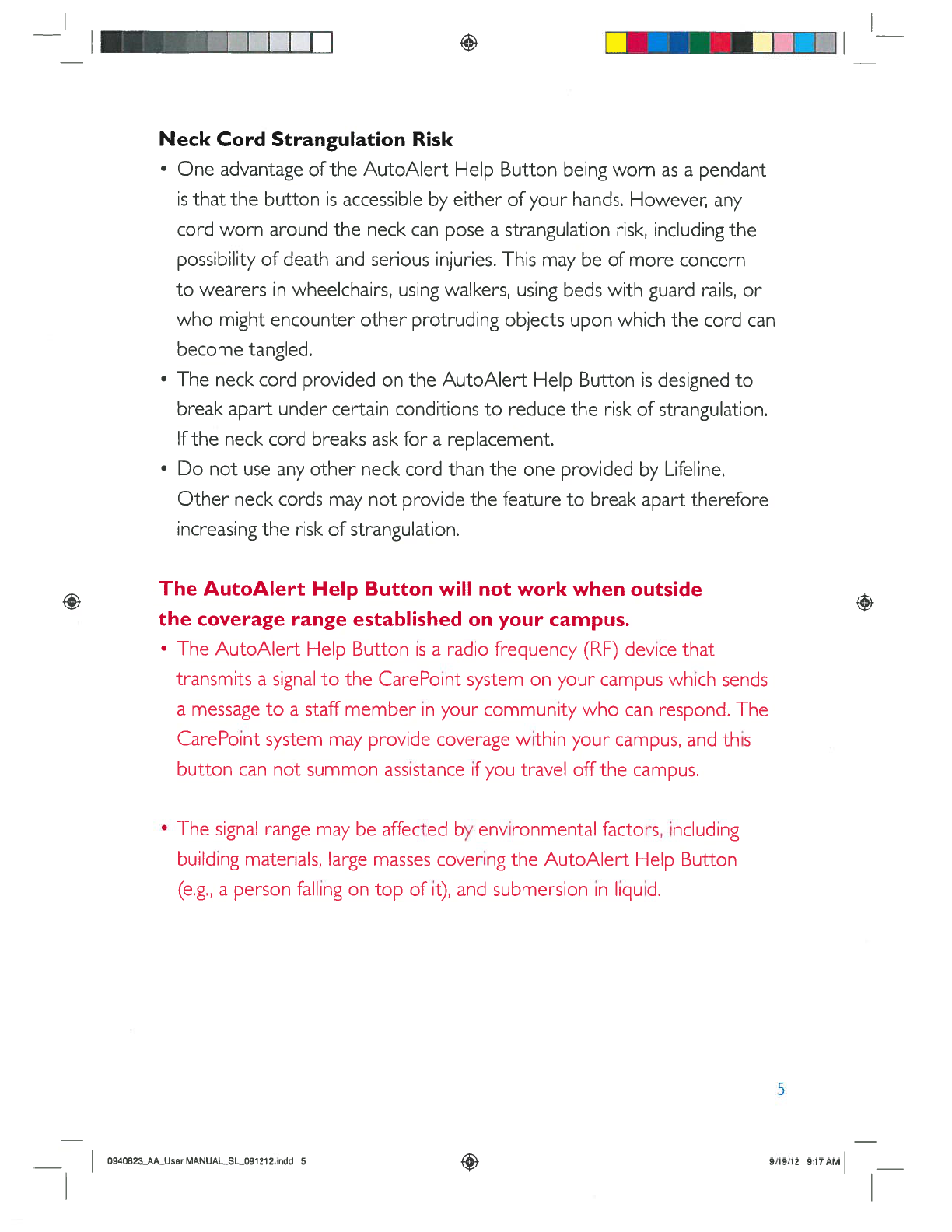
+
I
__
Neck
Cord
Strangulation
Risk
One
advantage
of
the
AutoAlert
Help
Button
being
worn
as
a
pendant
is
that
the
button
is
accessible
by
either
of
your
hands.
However,
any
cord
worn around
the
neck
can
pose
a
strangulation
risk,
including
the
possibility
of death
and
serious
injuries.
This
may
be
of
more
concern
to
wearers
in
wheelchairs,
using
walkers,
using
beds
with
guard
rails,
or
who
might
encounter
other
protruding
objects
upon
which
the
cord
can
become
tangled.
•
The
neck
cord
provided
on
the
AutoAlert
Help
Button
is
designed
to
break
apart
under
certain
conditions
to
reduce
the
risk
of
strangulation.
If
the
neck
cord
breaks
ask
for
a
replacement.
•
Do
not
use
any
other
neck cord
than
the
one
provided
by
Lifeline.
Other
neck
cords
may
not
provide
the
feature
to
break
apart therefore
increasing
the
risk
of
strangulation.
+
The
AutoAlert
Help
Button
will
not
work
when
outside
the
coverage
range established
on
your
campus.
•
The
AutoAlert
Help
Button
is
a
radio
frequency
(RF)
device
that
transmits
a
signal
to
the
CarePoint
system
on
your campus
which
sends
a
message
to
a
staff
member
in
your
community
who
can
respond.
The
CarePoint
system
may
provide
coverage
within
your
campus,
and
this
button
can
not
summon
assistance
if
you
travel
off
the
campus.
•
The
signal
range
may
be affected
by
environmental
factors,
including
building
materials,
large
masses
covering
the
AutoAlert
Help
Button
(e.g.,
a
person
falling
on
top
of
ii),
and
submersion
in
liquid.
5
O94B23_AA_UserMANUAL_SL_O91212indd
5
9/19/12 9:17AM
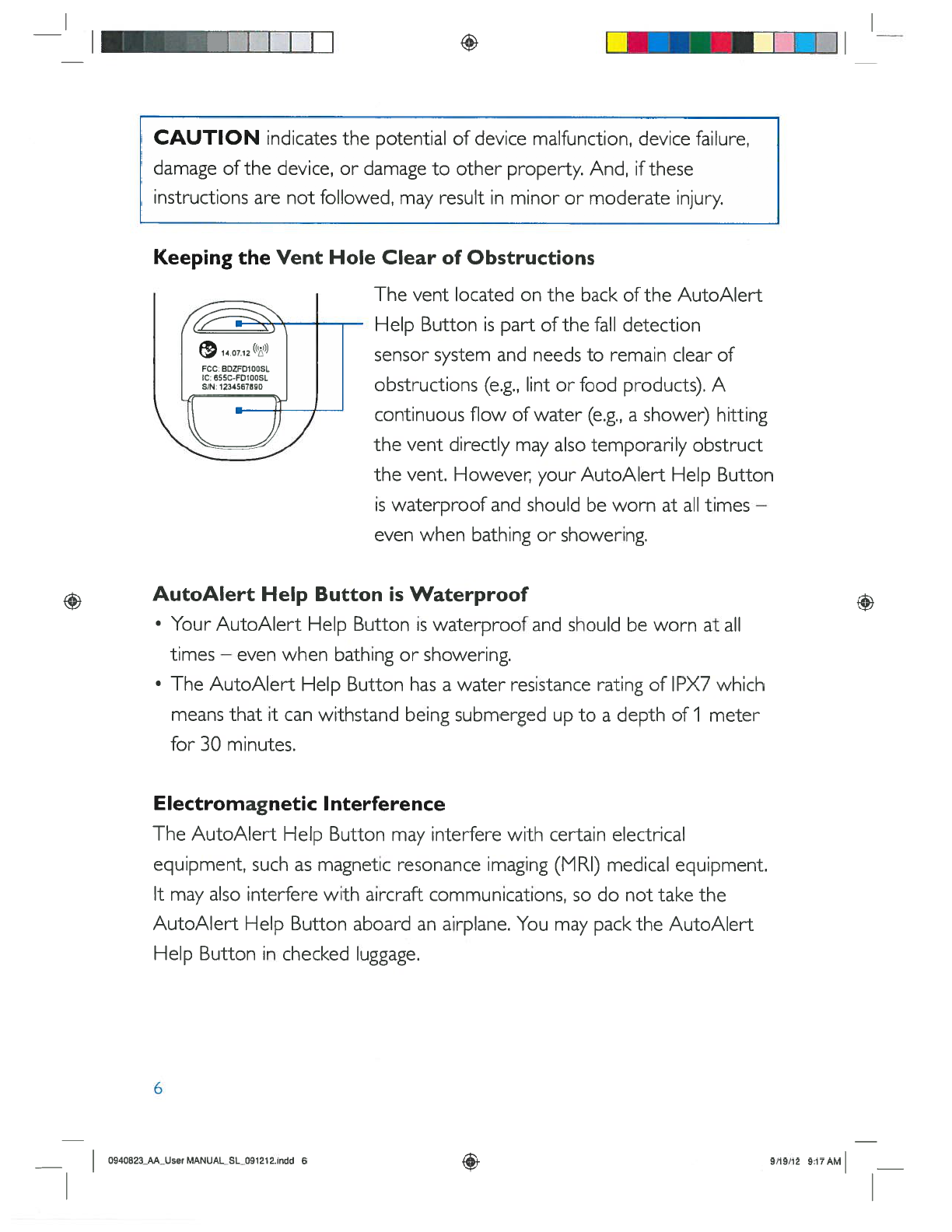
+
I
Keeping
the
Vent
Hole
Clear
of
Obstructions
The
vent
located
on
the
back
of
the
AutoAlert
Help
Button
is
part
of
the
fall
detection
sensor
system
and
needs
to
remain clear
of
obstructions
(e.g.,
lint
or
food products).
A
continuous
flow
of
water
(e.g.,
a
shower)
hitting
the
vent
directly
may
also
temporarily
obstruct
the
vent.
However your
AutoAlert
Help
Button
is
waterproof
and
should
be
worn
at
all
times
—
even
when
bathing
or
showering.
AutoAlert
Help
Button
is
Waterproof
•
Your
AutoAlert
Help
Button
is
waterproof
and
should
be
worn
at
all
times
—
even
when
bathing
or
showering.
•
The
AutoAlert
Help
Button
has
a
water
resistance
rating
of
IPX7
which
means
that
it
can
withstand
being
submerged
up
to
a
depth
of
1
meter
for
30
minutes.
Electromagnetic
Interference
The
AutoAlert
Help
Button
may
interfere
with
certain
electrical
equipment,
such
as
magnetic
resonance
imaging
(MRI)
medical
equipment.
It
may
also
interfere
with
aircraft
communications,
so
do
not
take
the
AutoAlert
Help
Button
aboard
an
airplane.
You
may
pack
the
AutoAlert
Help
Button
in
checked
luggage.
6
CAUTION
indicates
the
potential
of
device malfunction, device
failure,
damage
of
the
device,
or
damage
to
other
property.
And,
if
these
instructions
are
not
followed,
may
result
in
minor
or
moderate
injury.
0940823_AA_User
MANUAL_SL_091
21
2.indd
6
9/19/12 9:17AM
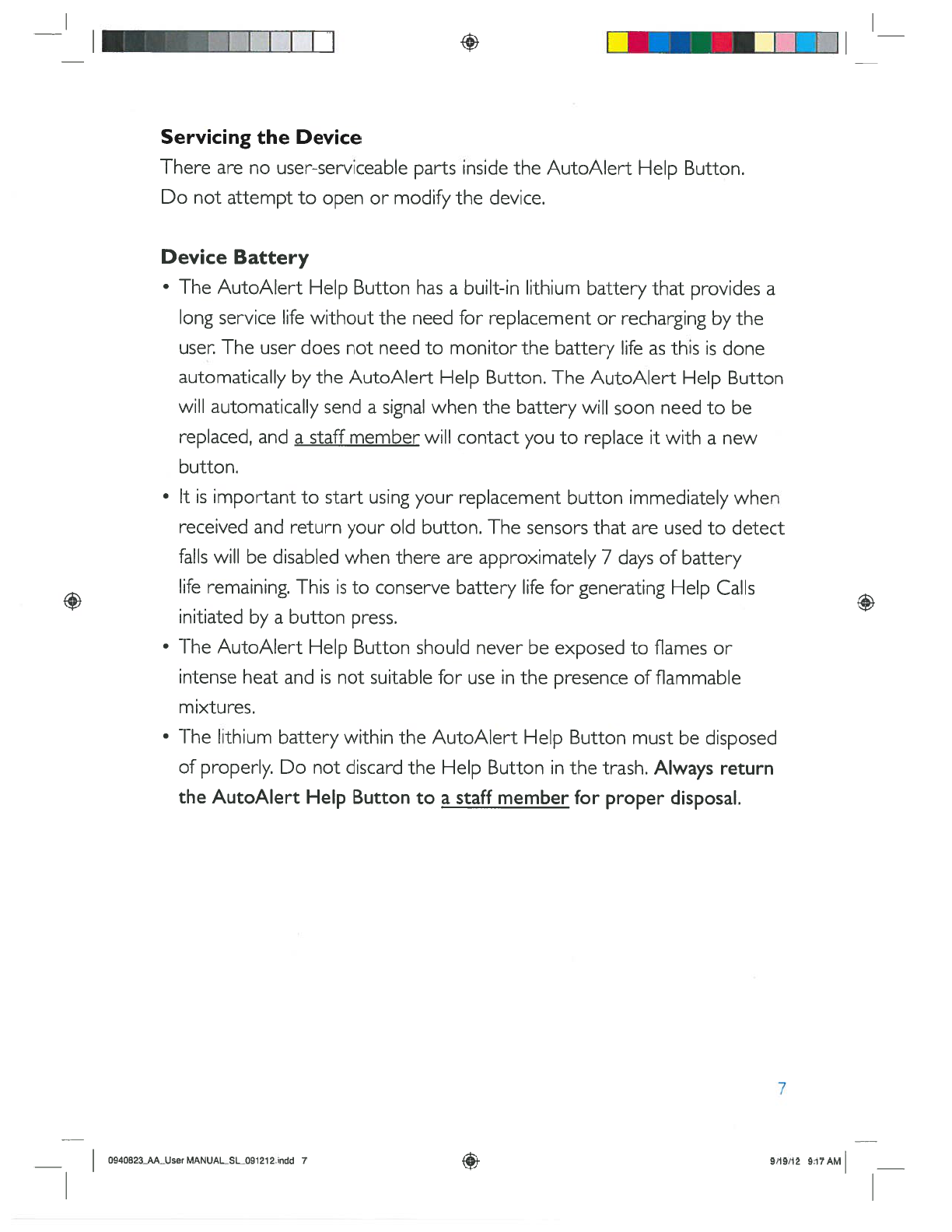
1IIII
I
I
Servicing
the
Device
There
are
no
user-serviceable
parts
inside
the
AutoAlert
Help
Button.
Do
not
attempt
to
open
or
modify
the
device.
Device
Battery
•
The
AutoAlert
Help
Button
has
a
built-in
lithium
battery
that
provides
a
long
service
life
without
the
need
for
replacement
or
recharging
by
the
user.
The
user
does
not
need
to
monitor
the
battery
life
as
this
is
done
automatically
by
the
AutoAlert
Help
Button.
The
AutoAlert
Help
Button
will
automatically
send
a
signal
when
the
battery
will
soon
need
to
be
replaced,
and
a
staff
member
will
contact
you
to
replace
it
with
a
new
button.
•
It
is
important
to
start
using
your
replacement
button
immediately
when
received
and
return
your
old
button.
The sensors
that
are
used
to
detect
falls
will
be
disabled
when
there
are
approximately
7
days
of
battery
life
remaining.
This
is
to
conserve
battery
life
for
generating
Help
Calls
initiated
by
a
button
press.
•
The
AutoAlert
Help
Button
should
never
be
exposed
to
flames
or
intense
heat
and
is
not
suitable
for
use
in
the
presence
of
flammable
mixtures.
•
The
lithium
battery
within
the
AutoAlert
Help
Button
must
be
disposed
of
properly.
Do
not
discard
the
Help
Button
in
the
trash.
Always
return
the
AutoAlert
Help
Button
to
a
staff
member
for
proper
disposal.
7
0940823_AA_User
MANUALSLO91212.jndd
7
9/19/12
917
AM
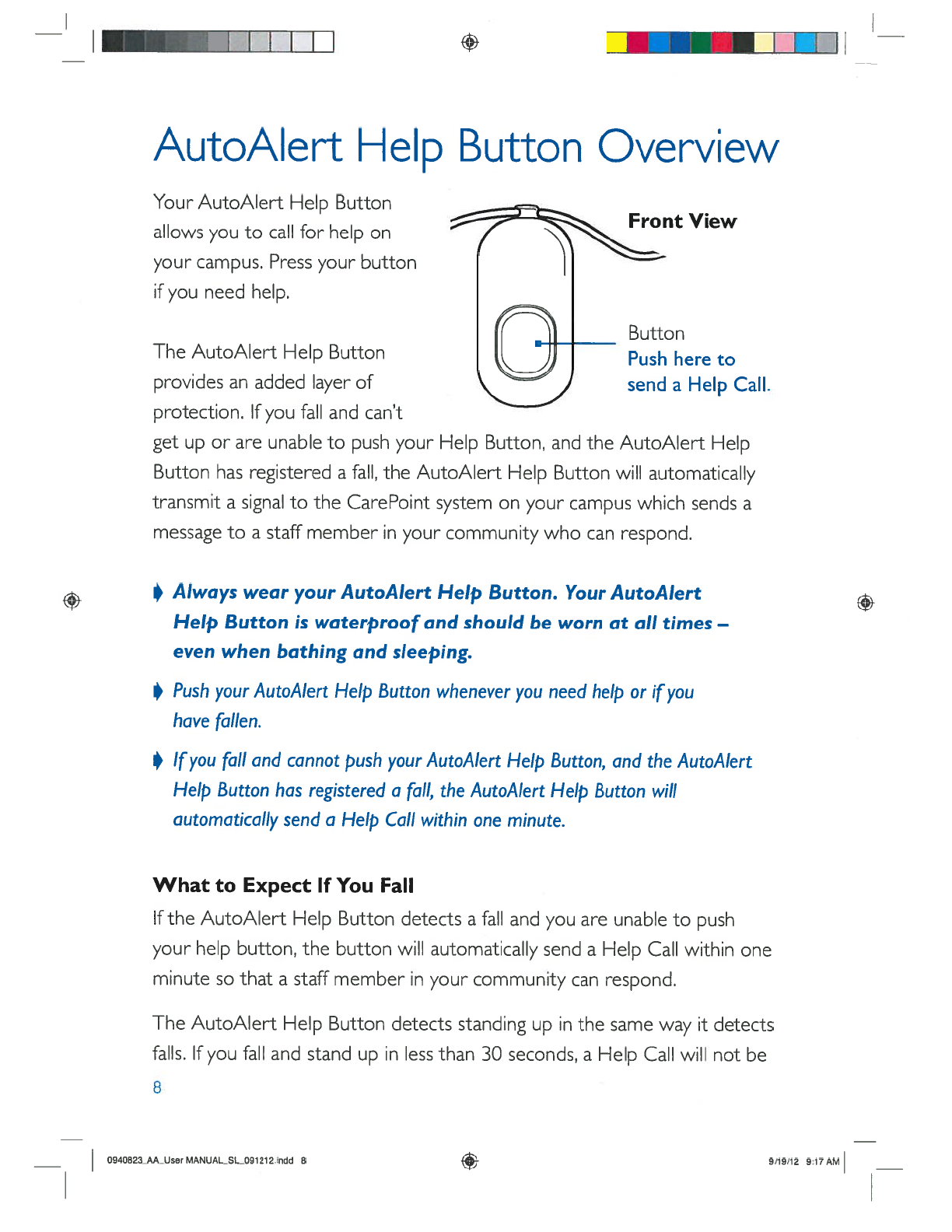
+
AutoAlert
Help
Button
Overview
Your
AutoAlert
Help
Button
allows
you
to
call
for
help
on
your
campus.
Press
your
button
if
you
need
help.
Button
Push
here
to
send
a
Help
Call.
The
AutoAlert
Help
Button
provides
an
added
layer
of
protection.
If
you
fall
and
can’t
get
up
or
are
unable
to
push
your
Help
Button,
and
the
AutoAlert
Help
Button
has
registered
a
fall,
the
AutoAlert
Help
Button
will
automatically
transmit
a
signal
to
the
CarePoint
system on
your
campus
which
sends
a
message
to
a
staff
member
in
your
community
who
can
respond.
•
Always
wear
your
AutoAlert
Help
Button.
Your
AutoAlert
Help
Button
is
waterproof
and
should
be
worn
at
all
times
—
even
when
bathing and
sleeping.
•
Push
your AutoAlert
Help
Button
whenever
you
need
help
or
if
you
have
fallen.
•
If
you
fall
and
cannot
push
your AutoAlert
Help
Button,
and
the
AutoAlert
Help
Button
has
registered
a
fall,
the
AutoAlert
Help
Button
will
automatically
send
a Help
Call
within
one
minute.
What
to
Expect
If
You
Fall
If
the
AutoAlert
Help
Button
detects
a
fall
and
you
are
unable
to
push
your
help
button,
the
button
will
automatically
send
a
Help
Call
within
one
minute
so
that
a
staff
member
in
your
community
can
respond.
The
AutoAlert
Help
Button
detects
standing
up
in
the
same
way
it
detects
falls.
If
you
fall
and
stand
up
in
less
than
30
seconds,
a
Help
Call
will
not
be
8
Front
View
0940B23_AA_User
MANUAL_SL091
21
2.indd
8
9/19/12
917AM
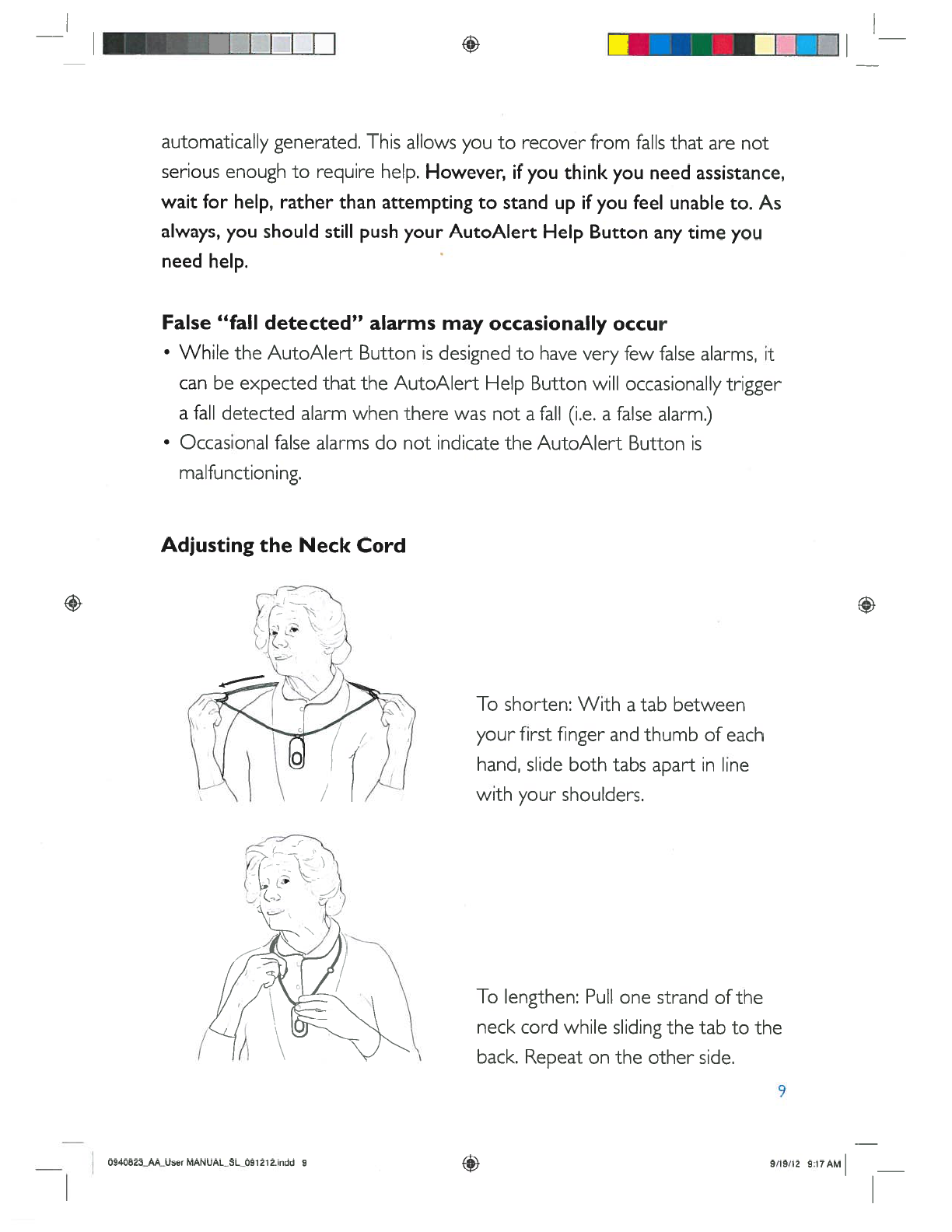
I
+
Adjusting
the
Neck
Cord
U
IU
automatically
generated.
This allows
you
to
recover
from
falls
that
are
not
serious
enough
to
require
help.
However,
if
you
think
you
need assistance,
wait
for
help,
rather
than
attempting
to
stand
up
if
you
feel
unable
to.
As
always,
you
should
still
push
your
AutoAlert
Help
Button
any
time
you
need
help.
False
“fall
detected”
alarms
may
occasionally
occur
•
While
the
AutoAlert
Button
is
designed
to
have
very
few
false
alarms,
it
can
be
expected
that the
AutoAlert
Help
Button
will
occasionally
trigger
a
fall
detected
alarm
when
there
was
not
a
fall
(i.e.
a
false
alarm.)
•
Occasional
false
alarms
do
not
indicate
the
AutoAlert
Button
is
malfunctioning.
To
shorten:
With
a
tab
between
your
first finger
and
thumb
of
each
hand,
slide
both
tabs
apart
in
line
with
your
shoulders.
To
lengthen:
Pull
one
strand of
the
neck
cord
while
sliding
the tab to
the
back.
Repeat
on
the other
side.
9
O94O823AA_User
MANUAL_SL_091
21
2.indd
9
9/19112
9:17AM
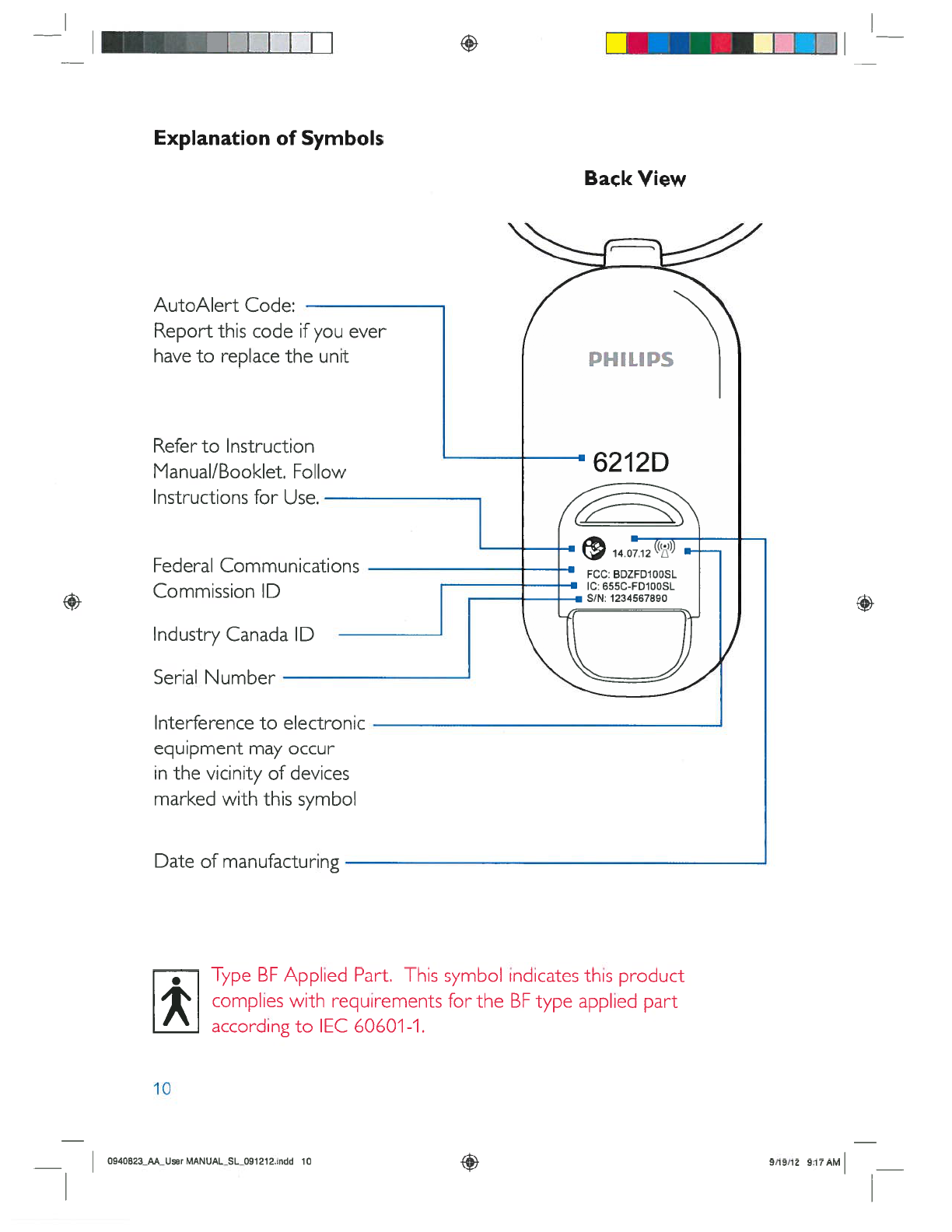
I
I
I
I
Explanation
of
Symbols
Back
View
I
—
AutoAlert
Code:
Report
this
code
if
you
ever
have
to
replace
the
unit
Refer
to
Instruction
Manual/Booklet.
Follow
Instructions
for
Use.
Federal
Communications
Commission
ID
Industry
Canada
ID
Serial
Number
Interference
to
electronic
equipment
may
occur
in
the
vicinity
of
devices
marked
with
this
symbol
Date
of manufacturing
10
Type
BF
Applied Part.
This
symbol indicates this
product
complies
with
requirements
for
the
BE
type
applied
part
according
to
IEC
60601
-1.
PHILIPS
6212D
0940823AA_User
MANUAL_SL_091
21
2.indd
10
9/19/12 9:17AM
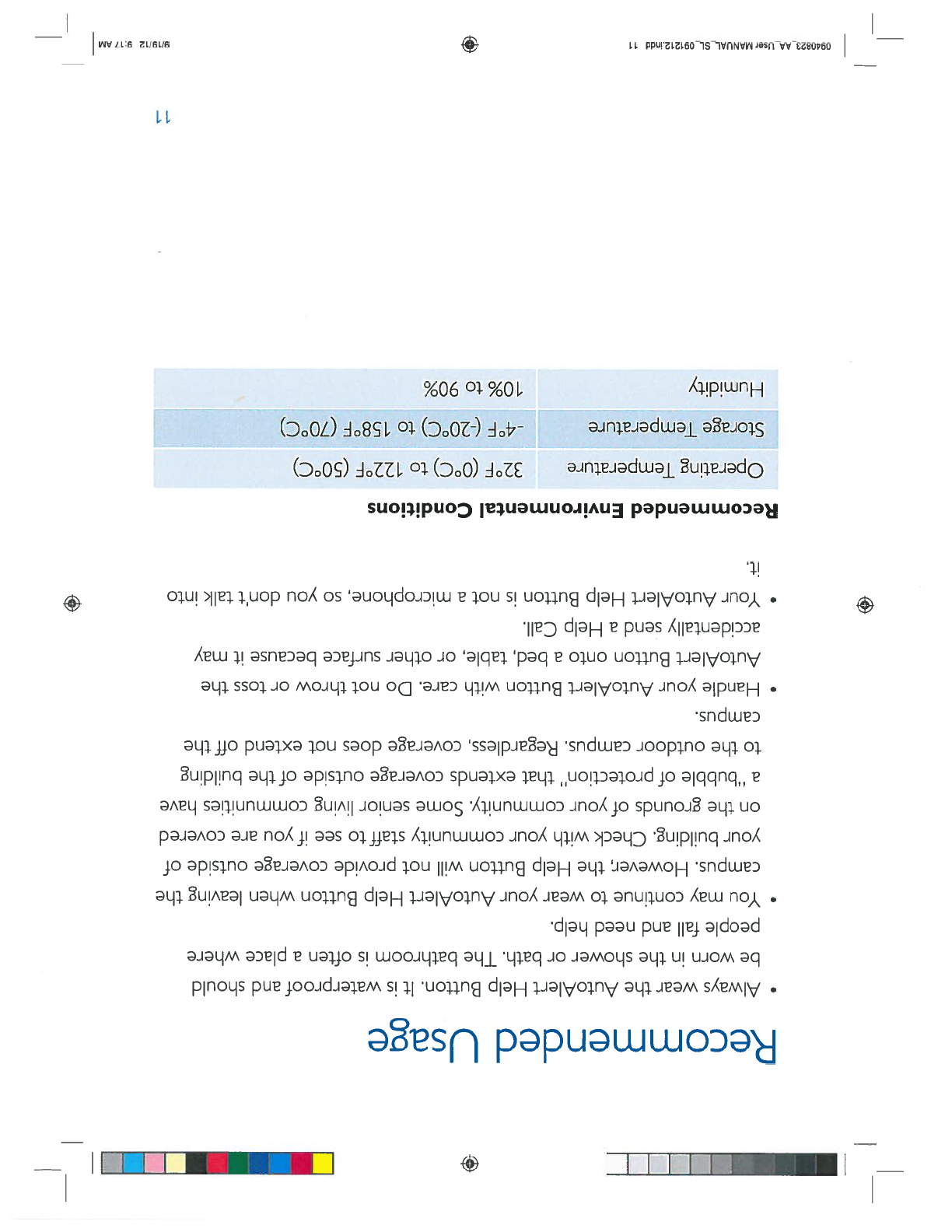
Recommended
Usage
—
+
•
Always
wear
the
AutoAlert
Help
Button.
It
is
waterproof
and
should
be
worn
in
the
shower
or
bath.
The
bathroom
is
often
a
place
where
people
fall
and
need
help.
•
You
may
continue
to
wear
your
AutoAlert
Help
Button
when
leaving
the
campus. However,
the
Help
Button
will
not
provide
coverage
outside
of
your
building.
Check
with
your
community
staff
to
see
if
you
are
covered
on
the
grounds
of
your
community.
Some
senior
living
communities
have
a
bubble
of
protection”
that
extends
coverage
outside
of
the
building
to
the outdoor
campus.
Regardless,
coverage
does
not
extend
off
the
campus.
•
Handle
your
AutoAlert
Button
with
care.
Do
not
throw
or
toss
the
AutoAlert
Button
onto
a
bed,
table,
or
other
surface
because
it
may
accidentally
send
a
Help
Call.
•
Your
AutoAlert
Help
Button
is
not
a
microphone,
so
you
don’t talk
into
it.
Recommended
Environmental
Conditions
Operating
Temperature
Storage
Temperature
Humidity
32°F
(0°C)
to
122°F
(50°C)
-4°F
(-20°C)
to
158°F
(70°C)
10%to9O%
11
0940823
AA
User
MANUAL.SL_091
21
2indd
11
9/19/12
9:17AM
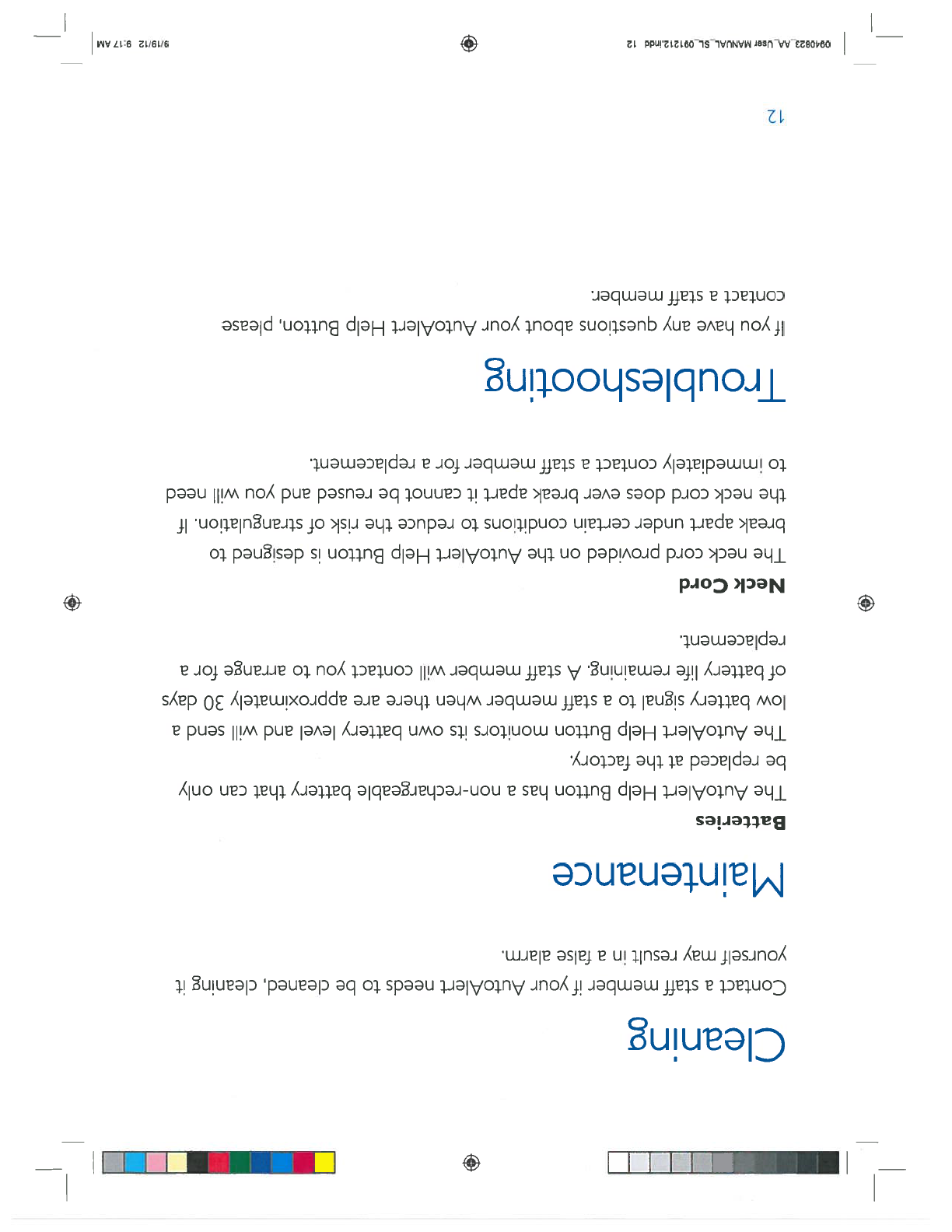
Cleaning
Contact
a
staff
member
if
your
AutoAlert
needs
to
be cleaned,
cleaning
it
yourself
may
result
in
a
false
alarm.
Maintenance
Batteries
The
AutoAlert
Help
Button
has
a
non-rechargeable
battery
that
can
only
be
replaced
at
the
factory.
The
AutoAlert
Help
Button
monitors
its
own
battery
level
and
will
send
a
low
battery
signal
to
a
staff
member
when
there
are
approximately
30
days
of
battery
life
remaining.
A
staff
member
will
contact
you
to
arrange
for
a
replacement.
Neck
Cord
The
neck
cord
provided
on
the
AutoAlert
Help
Button
is
designed
to
break
apart
under
certain
conditions
to
reduce
the
risk
of strangulation.
If
the
neck cord
does
ever
break
apart
it
cannot
be
reused
and
you
will
need
to
immediately
contact
a
staff
member
for
a
replacement.
Troubleshooting
If
you
have
any
questions
about
your
AutoAlert
Help
Button,
please
contact
a
staff
member.
12
0940823_AA..User
MANUAL_SL_091212.indd
12
9/19/12 9:17
AM
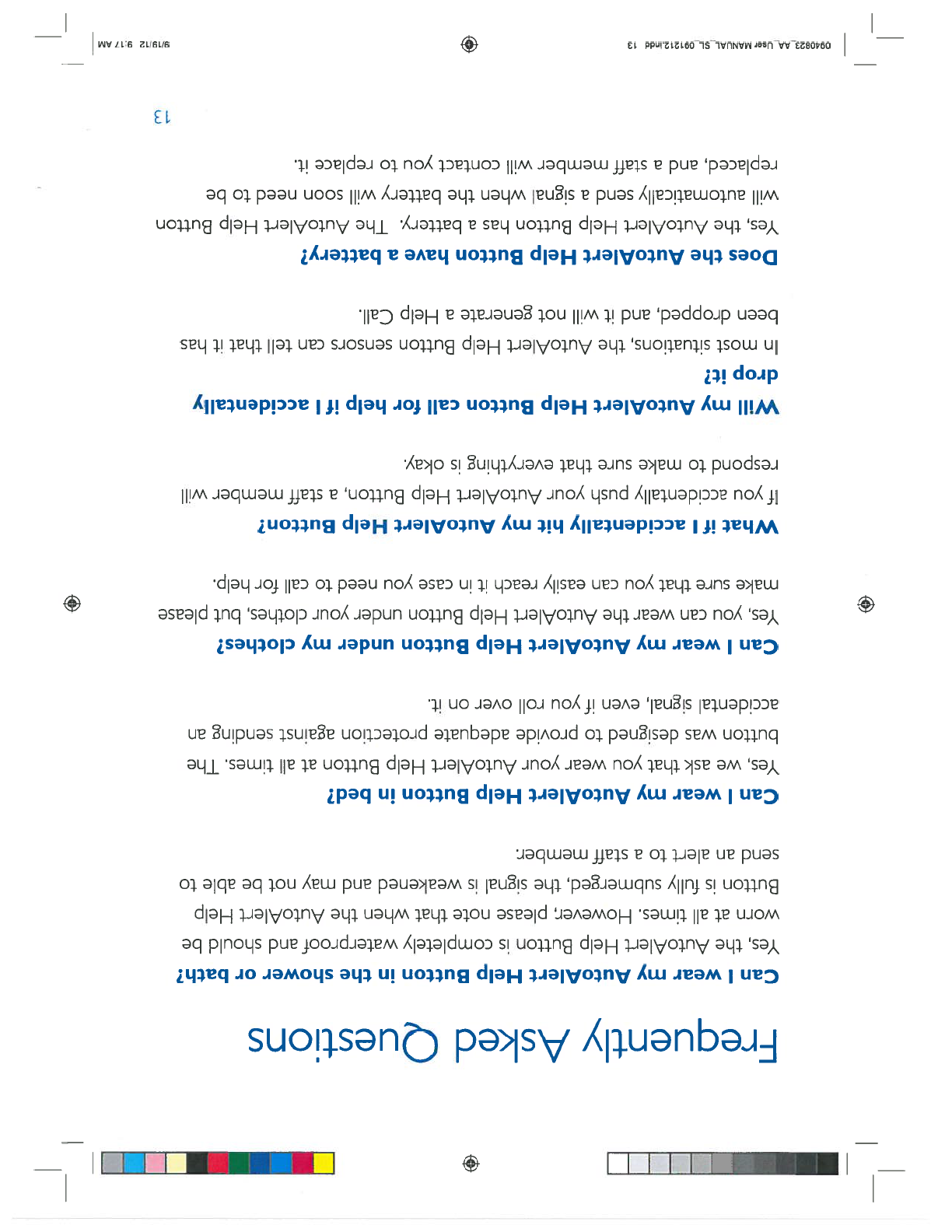
I
I
I
I I
II
•
1
Frequently
Asked
Questions
Can
I
wear
my
AutoAlert
Help
Button
in
the
shower or
bath?
Yes,
the
AutoAlert
Help
Button
is
completely
waterproof
and
should
be
worn
at
all
times.
However,
please
note
that
when
the
AutoAlert
Help
Button
is
fully
submerged,
the
signal
is
weakened
and
may
not
be
able
to
send
an
alert
to
a
staff
member.
Can
I
wear
my
AutoAlert
Help
Button
in
bed?
Yes,
we
ask
that
you
wear
your
AutoAlert
Help
Button
at
all
times.
The
button
was
designed
to
provide
adequate
protection
against sending
an
accidental
signal,
even
if
you
roll
over
on
it.
Can
I
wear
my
AutoAlert
Help
Button
under
my
clothes?
Yes,
you
can
wear
the
AutoAlert
Help
Button
under
your
clothes,
but
please
make
sure
that
you can
easily
reach
it
in
case
you
need
to
call
for
help.
What
if
I
accidentally
hit
my
AutoAlert
Help
Button?
If
you
accidentally push
your
AutoAlert
Help
Button,
a
staff
member
will
respond
to
make
sure
that
everything
is
okay.
Will
my
AutoAlert
Help
Button
call
for
help
if
I
accidentally
drop
it?
In
most
situations,
the
AutoAlert
Help
Button
sensors
can
tell
that
it
has
been
dropped,
and
it
will
not
generate
a
Help
Call.
Does
the
AutoAlert
Help
Button
have
a
battery?
Yes,
the
AutoAlert
Help
Button
has
a
battery.
The
AutoAlert
Help
Button
will
automatically send
a
signal
when
the
battery
will
soon
need
to
be
replaced,
and
a
staff
member
will
contact
you
to
replace
it.
13
0940823_AA_User
MANUAL_SL_O9212.indd
13
9/19/12 9:17
AM
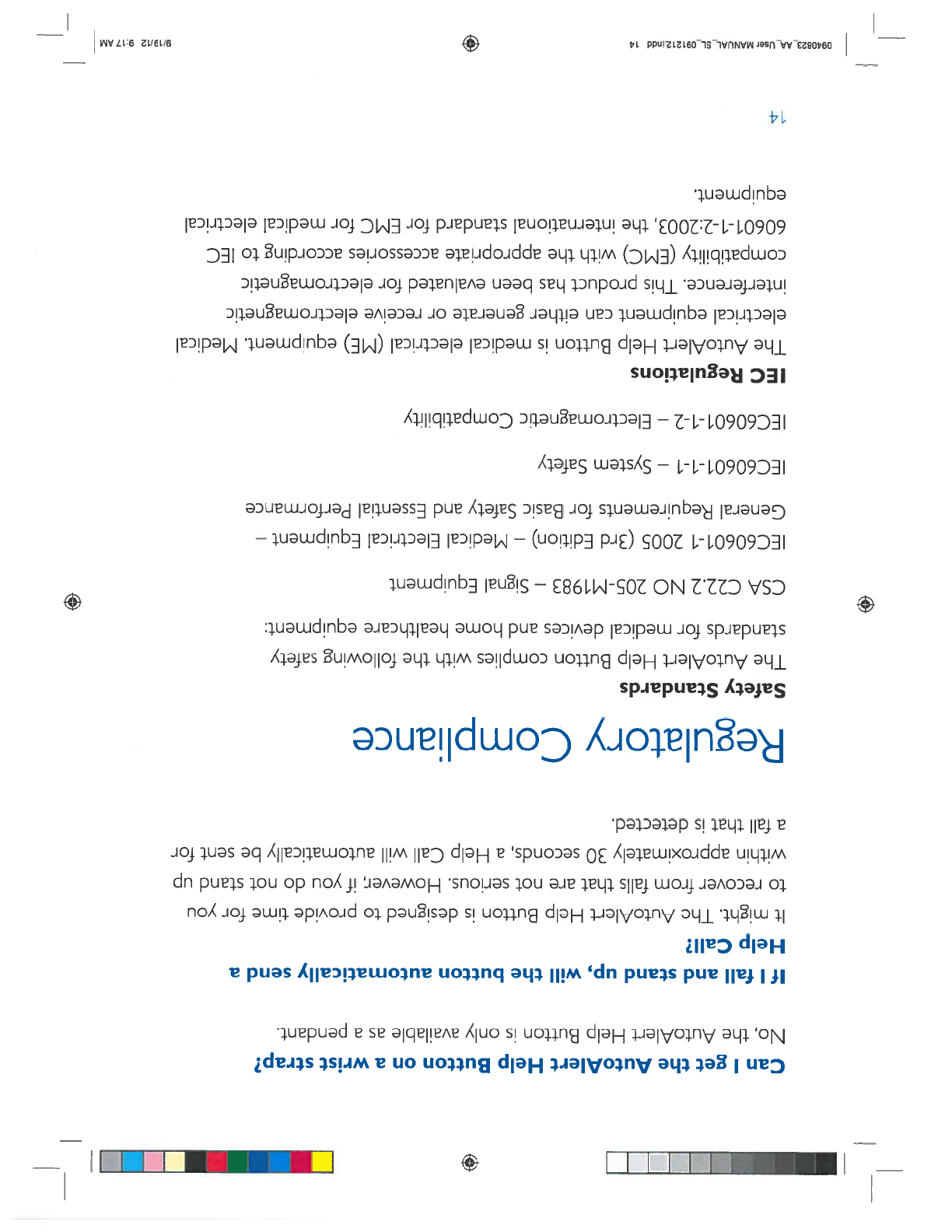
IBII
Can
I
get
the
AutoAlert
Help
Button
on
a
wrist
strap?
No,
the
AutoAlert
Help
Button
is
only available
as
a
pendant.
If
I
fall
and
stand
up,
will
the
button
automatically
send
a
Help
Call?
It
might.
The
AutoAlert
Help
Button
is
designed
to
provide
time for
you
to
recover
from
falls
that
are
not
serious. However,
if
you
do
not
stand
up
within
approximately
30
seconds,
a
Help
Call
will
automatically
be
sent
for
a
fall
that
is
detected.
Regulatory
Compliance
Safety
Standards
The
AutoAlert
Help
Button
complies
with
the
following
safety
standards
for
medical
devices
and
home healthcare
equipment:
+
CSA
C22.2
NO
205-M1983
—
Signal
Equipment
1EC60601-1
2005
(3rd
Edition)
—
Medical Electrical
Equipment
—
General
Requirements
for
Basic
Safety
and
Essential
Performance
1EC60601-1-1
—
System
Safety
I
EC60601
-1-2
—
Electromagnetic
Compatibility
IEC
Regulations
The
AutoAlert
Help
Button
is
medical
electrical
(ME)
equipment.
Medical
electrical
equipment
can
either
generate
or
receive
electromagnetic
interference.
This
product
has
been
evaluated
for
electromagnetic
compatibility
(EM
C)
with
the
appropriate
accessories
according
to
IEC
60601-1-2:2003,
the
international
standard
for
EMC
for
medical
electrical
equipment.
14
—
0940823
AA
User
MANUAL_SL091
21
2.indd
14
+
I
9/19/12 9:17AM
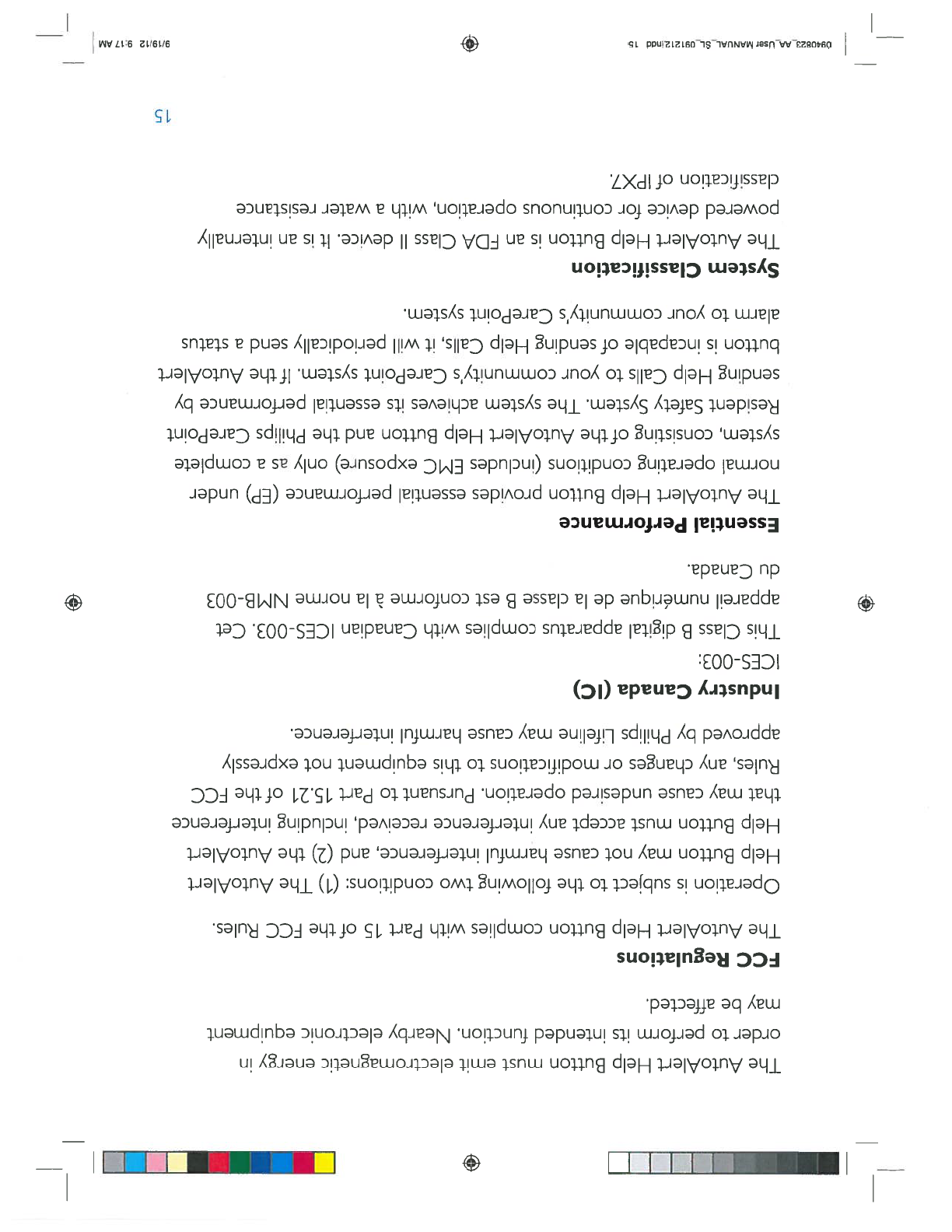
IRBI
+
I
__
15
9/19/12
9:17
AM
The
AutoAlert
Help
Button
must emit
electromagnetic
energy
in
order
to
perform
its
intended
function.
Nearby
electronic
equipment
may
be
affected.
FCC
Regulations
The
AutoAlert
Help
Button
complies
with
Part
15
of
the
FCC
Rules.
Operation
is
subject
to
the
following
two
conditions:
(1)
The
AutoAlert
Help
Button
may
not
cause
harmful
interference,
and
(2)
the
AutoAlert
Help
Button
must accept
any
interference
received,
including
interference
that
may
cause
undesired
operation.
Pursuant
to
Part
15.21
of
the
FCC
Rules,
any
changes
or
modifications
to
this
equipment
not
expressly
approved
by
Philips
Lifeline
may
cause
harmful
interference.
Industry
Canada
(IC)
ICES
-003:
This
Class
B
digital
apparatus
complies
with
Canadian
ICES-003.
Cet
appareil
numérique
de
a
classe
B
est
conforme
a
a
norme
NMB-003
ciu
Canada.
Essential
Performance
The
AutoAlert
Help
Button
provides
essential
performance
(EP)
under
normal
operating
conditions
(includes
EMC
exposure)
only
as
a
complete
system,
consisting
of
the
AutoAlert
Help
Button
and
the
Philips
CarePoint
Resident
Safety
System.
The
system
achieves
its
essential
performance
by
sending
Help
Calls
to
your
community’s
CarePoint
system.
If
the
AutoAlert
button
is
incapable
of
sending
Help
Calls,
it
will
periodically
send
a
status
alarm
to
your
community’s
CarePoint
system.
System
Classification
The
AutoAlert
Help
Button
is
an FDA
Class
II
device.
It
is
an
internally
powered
device
for
continuous
operation,
with
a
water
resistance
classification
of
IPX7.
0940823_AA_User
MANUAL_SL_091
21
2.incid
15
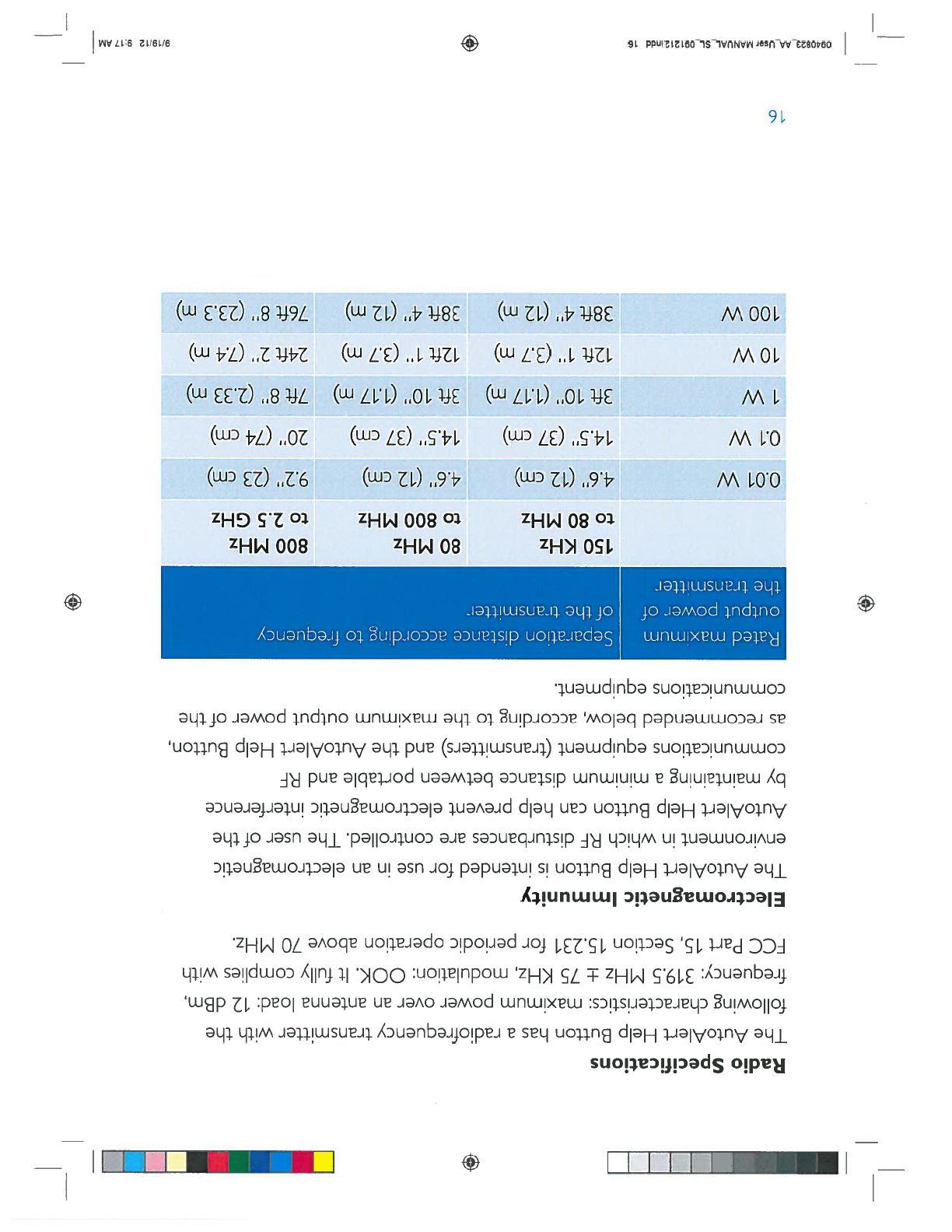
Radio
Specifications
The
AutoAlert
Help
Button
has
a
radiofrequency
transmitter
with
the
following
characteristics: maximum
power
over
an
antenna
load:
12
clBm,
frequency:
319.5
MHz
±
75
KHz,
modulation:
00K.
It
fully
complies with
FCC
Part
15,
Section
15.231
for periodic
operation
above
70
MHz.
Electromagnetic
Immunity
The
AutoAlert
Help
Button
is
intended for
use
in
an
electromagnetic
environment
in
which
RF
disturbances
are
controlled.
The user
of
the
AutoAlert
Help
Button
can
help
prevent
electromagnetic
interference
by
maintaining
a
minimum
distance
between portable
and
RF
communications
equipment
(transmitters)
and
the
AutoAlert
Help
Button,
as
recommended
below,
according
to
the
maximum
output
power
of
the
communications
equipment.
Rated
maximum
Separation
distance
according
to
frequency
output
power
of
of
the transmitter
the
transmitter
150
KHz
80
MHz
800
MHz
to
80
MHz
to
800
MHz
to
2.5
GHz
0.01
W
4.6’
(12
cm)
4.6”
(12
cm)
9.2’
(23
cm)
0.1
W
14.5”
(37
cm)
14.5”
(37
cm)
20”
(74
cm)
1
‘N
3ft
10”
(1.17 m)
3ft
10”
(1.17
m)
7ft
8”
(233
m)
10
‘N
l2ft
1”
(3.7
m)
l2ft
1”
(3.7
m)
24ft
2”
(7.4
m)
100
W
38ft
4”
(12
m)
38ft
4”
(12 m)
76ft
8”
(23.3
m)
16
0940823_AA_User
MANUAL_SL_091212indd
16
9/19/12
9:17
AM
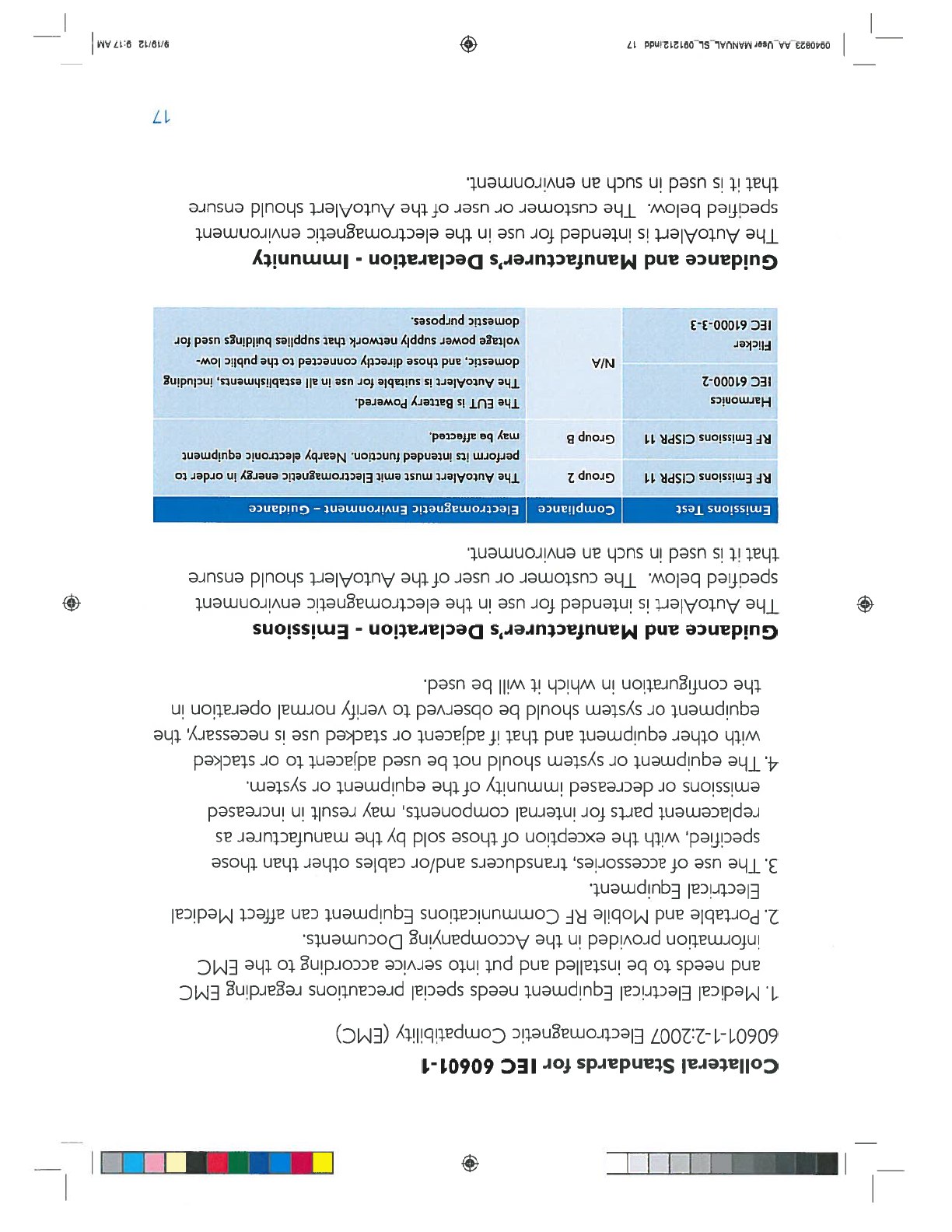
I
i•i
Collateral
Standards
for
IEC
60601-1
60601-1-2:2007
Electromagnetic
Compatibility
(EMC)
1.
Medical
Electrical
Equipment
needs
special
precautions
regarding
EMC
and
needs
to
be
installed
and
put
into
service according
to
the
EMC
information
provided
in
the
Accompanying
Documents.
2.
Portable
and
Mobile
RF
Communications
Equipment
can
affect
Medical
Electrical
Equipment.
3.
The
use
of
accessories,
transducers
and/or
cables
other
than
those
specified,
with
the
exception
of
those
sold
by
the
manufacturer
as
replacement
parts
for
internal
components,
may
result
in
increased
emissions
or
decreased
immunity
of
the equipment
or
system.
4.
The
equipment
or
system
should
not
be
used
adjacent
to or
stacked
with
other
equipment
and
that
if
adjacent
or
stacked
use
is
necessary,
the
equipment
or
system
should
be
observed
to
verify
normal
operation
in
the
configuration
in
which
it
will
be
used.
Guidance
and
Manufacturer’s
Declaration
-
Emissions
The
AutoAlert
is
intended
for
use
in
the
electromagnetic
environment
specified
below.
The
customer
or
user
of
the
AutoAlert
should
ensure
that
it
is
used
in
such
an
environment.
Emissions
Test
Compliance
Electromagnetic
Environment
—
Guidance
RF
Emissions
CISPR
11
Group
2
The
AutoAlert
must
emit Electromagnetic
energy
in
order
to
perform
its
intended
function.
Nearby
electronic equipment
RF
Emissions
CISPR
11
Group
B
may
be
affected.
Harmonics
The
EUT
is
Battery
Powered.
IEC
61000-2
The
AutoAlert
is
suitable for
use
in
all
establishments,
including
N/A
domestic,
and
those
directly
connected
to the
public low-
Flicker
voltage
power
supply
network
that
supplies
buildings
used for
IEC
61
000-3-3
domestic
purposes.
Guidance
and
Manufacturer’s
Declaration
-
Immunity
The
AutoAlert
is
intended
for
use
in
the
electromagnetic environment
specified
below.
The
customer
or
user
of
the
AutoAlert
should
ensure
that
it
is
used
in
such
an
environment.
17
0940823_AA_User
MANUAL_SL_091212indd
17
.43
9/19/12
9:17
AM
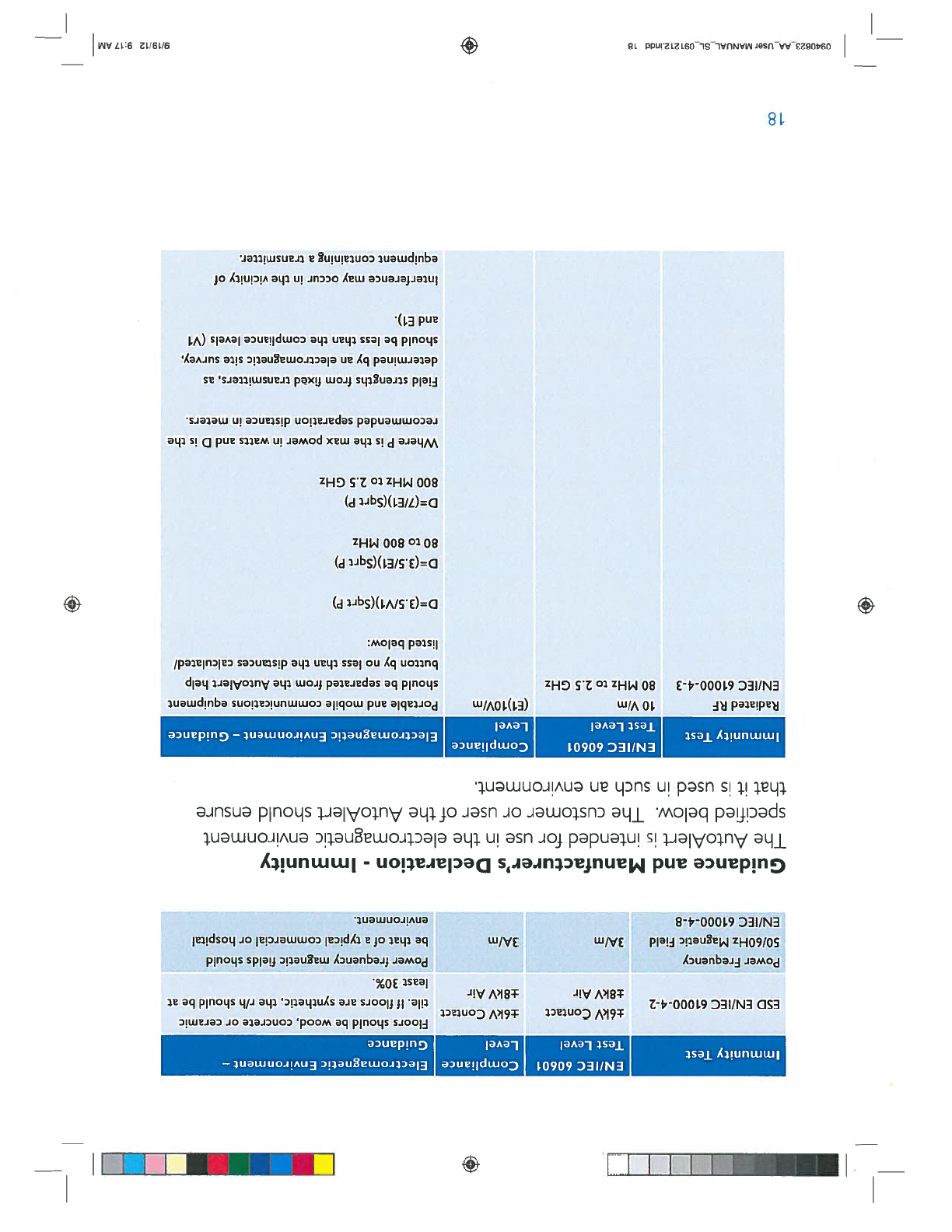
I
I I
II
+
I
ENIIEC
60601
I
Compliance
I
Electromagnetic Environment
—
Immunity Test
I
Test
Level
Level
Guidance
ESD
EN/IEC
61
000-4-2
Power
Frequency
50/60Hz
Magnetic
Field
EN/IEC
61
000-4-8
±6kV
Contact
±8kV
Air
±6kv
Contact
±8kV
Air
Floors should
be
wood,
concrete or
ceramic
tile.
If
floors
are
synthetic,
the
nh
should
be
at
least
30%.
Power
frequency
magnetic
fields
should
be
that
of
a
typical
commercial
or
hospital
environment.
Guidance
and
Manufacturer’s
Declaration
-
Immunity
The
AutoAlert
is
intended for
use
in
the
electromagnetic
environment
specified
below.
The
customer
or
user
of
the
AutoAlert
should
ensure
that
it
is
used
in
such
an
environment.
ENIIEC
60601
Compliance
Immunity Test
Electromagnetic
Environment
—
Guidance
Test
Level
Level
Radiated
RF
EN/IEC
61
000-4-3
10
V/m
80
MHz
to
2.5
GHz
(E1)lOVIm
Portable
and
mobile
communications
equipment
should
be
separated
from
the
AutoAlert
help
button
by
no
less
than
the
distances
calculated/
listed below:
18
D=(3.51V1)(Sqrt
P)
D(3.5/E1)(Sqrt
P)
80
to
800
MHz
D(7/E1)(Sqrt
P)
800
MHz
to
2.5
GHz
Where
P is
the
max
power
in
watts
and
D
is
the
recommended
separation
distance
in
meters.
Field
strengths
from
fixed
transmitters,
as
determined
by
an
electromagnetic
site
survey,
should
be
less
than the
compliance
levels
(VI
and
El).
Interference
may
occur
in
the
vicinity
of
equipment
containing
a
transmitter.
+
0940823_AA_User
MANUALSL_091 212.indd
18
9/19/12
9:17AM
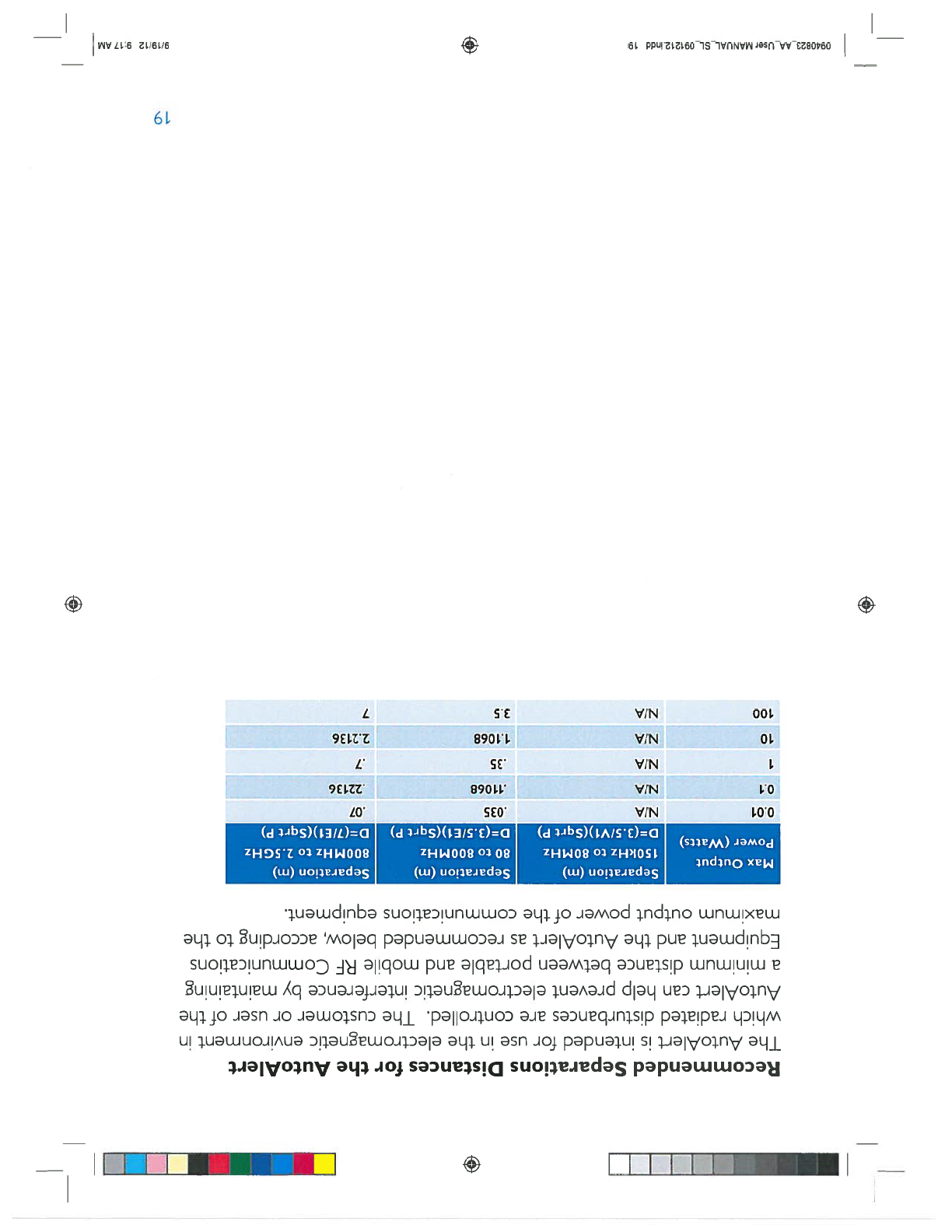
Recommended
Separations
Distances for
the
AutoAlert
The
AutoAlert
is
intended for
use
in
the
electromagnetic
environment
in
which
radiated
disturbances
are
controlled.
The
customer or
user
of
the
AutoAlert
can
help
prevent
electromagnetic
interference
by
maintaining
a
minimum
distance
between
portable
and
mobile
RE
Communications
Equipment
and
the
AutoAlert
as
recommended
below,
according
to
the
maximum
output
power
of
the
communications
equipment.
Separation
(m)
Separation
(m)
Separation
(m)
Max
Output
150kHz
to
80MHz
80
to
800MHz 800MHz
to
2.5GHz
Power
(Watts)
D(3.51V1)(Sqrt
P)
D(3.5/E1)(Sqrt
P)
D(7/E1)(Sqrt
P)
0.01
N/A
.035
.07
0.1
N/A
.11068
.22136
I
N/A
.35
.7
10
N/A
1.1068
2.2136
100
N/A
3.5
7
+
19
O94O823_AAUser
MANUAL_SL_091212Jndd
19
9/19/12 9:17
AM
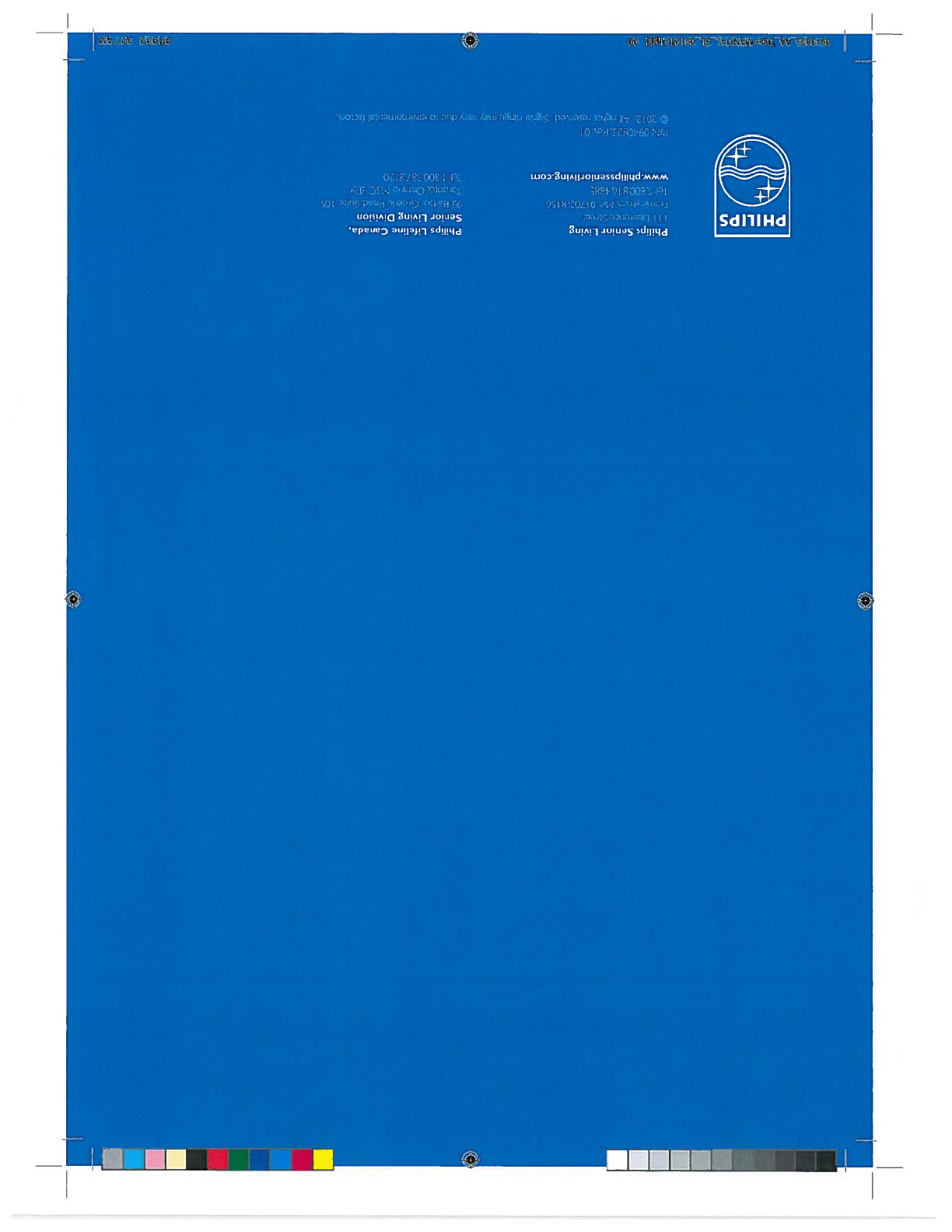
I
I I